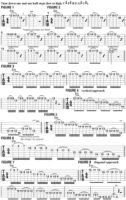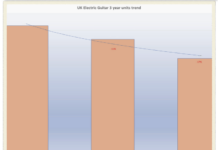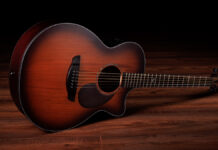
Horizontal and Vertical Natural-Minor Runs
In my previous two columns (find them under RELATED ARTICLES, below), I introduced a handful of very specific methods to study licks based on pentatonic scales.
We examined the standard “Western” minor pentatonic scale, spelled 1[root] b3 4 5 b7, as well as the Japanese Hirajoshi scale, or “Eastern” pentatonic, which is spelled 1[root] 2 b3 5 b6.
This month, we’ll incorporate a modal approach, utilizing our E minor pentatonic scale with the inclusion of the major second, F# and the minor, or “flatted,” sixth, C, resulting in the E natural minor scale, also known as the E Aeolian mode: E F# G A B C D (spelled 1[root] 2 3 4 5 b6 b7).
This scale works well over chords like Em and its offshoots Em7, Em9, Emb6, Em-sus4 and Em7b13. As we had done previously, each group of notes, or “cell,” is going to be a repeating four-note shape that moves up and down the fretboard while remaining diatonic to (within the scale structure of) E natural minor.
If we begin with the four-note cell presented in FIGURE 1 (E F#E D), we can change its shape slightly by starting on each subsequent scale degree of E natural minor. As shown in FIGURE 2, I begin by playing E-F#-E-D twice, and then I move up the fretboard so that I can begin the cell on the next higher scale degree, F#, resulting in the cell F#-G-F#-E. Likewise, the following cell is G-A-G-F#, followed by A-B-A-G and finally B-C-B-A.
I then descend through the previous four shapes and additionally descend to cells that begin on the notes D, C and B before ascending back to our starting point. Each cell is articulated with a picked note followed by a hammer/pull on the same string and ending with a picked note on the next lower string. I like to keep my fret-hand fingers positioned directly above the board in order to facilitate some of the wide stretches required to reach a few of these shapes.
FIGURE 3 is quite a bit more challenging in that the tempo is doubled and each cell is played only once. I use a downstroke for the initial pick attack and an upstroke for the note sounded on the B string. Work through this drill slowly, increasing the tempo gradually. This technique can be applied to a “vertical” approach—moving across the strings—as demonstrated in FIGURES 4 and 5. After playing the sequence descending, as shown, reverse the process by playing it in an ascending manner.
In FIGURES 6 and 7, I begin each pattern on a note of an E minor triad (E G B), and in FIGURE 8 I employ a “diagonal” approach with hammers/pulls, placing some of the four-note cells on one string. Switching between this kind of legato articulation and straight alternate picking is good for expanding dynamic versatility.
Source: www.guitarworld.com











